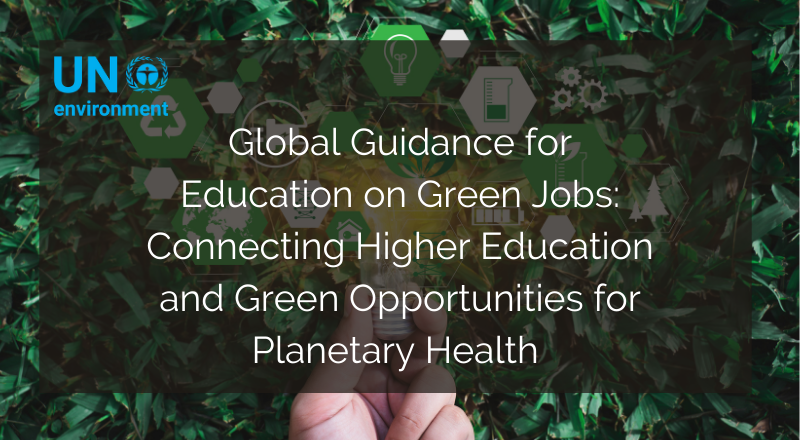The goal of the guidance is to lead to a greener economy and provide better job opportunities for young people. This initiative consists of a top down effort via UNEP's Youth and Education Alliance and relevant ministries, as well as a bottom up effort via youth engagement and through pathways for connected implementation via enhancing education and employer connections.
New initiative - Global Guidance for Education on Green Jobs: Connecting Higher Education and Green Opportunities for Planetary Health from UNEP's Youth and Education Alliance is designed to increase demand for green jobs in the workforce and help create a stronger supply of necessary green and environmental sustainability skills through education.
The goal of the guidance is to lead to a greener economy and provide better job opportunities for young people. This initiative consists of a top down effort via UNEP's Youth and Education Alliance and relevant ministries, as well as a bottom up effort via youth engagement and through pathways for connected implementation via enhancing education and employer connections.
1.Top Down - UNEP (with other UN agencies) and relevant ministries are provided with a draft letter (open to customization for each country) to send out to high school and university/technical colleges. The letter will be valuable to chief academic officers, educators, youth and career advisors and university department chairs. The letter highlights:
The goal of the guidance is to lead to a greener economy and provide better job opportunities for young people. This initiative consists of a top down effort via UNEP's Youth and Education Alliance and relevant ministries, as well as a bottom up effort via youth engagement and through pathways for connected implementation via enhancing education and employer connections.
1.Top Down - UNEP (with other UN agencies) and relevant ministries are provided with a draft letter (open to customization for each country) to send out to high school and university/technical colleges. The letter will be valuable to chief academic officers, educators, youth and career advisors and university department chairs. The letter highlights:
- The growth of green jobs
- How to bring a green lens to any job/organization
- Green jobs pathways (e.g. skills/educational/career pathways)
- How students can get involved with green opportunities today (e.g. ways to include applied, real world projects in curricula as a high impact learning practice for undergraduate and Masters projects, and MA/MS/ PhD practical theses).
- The need to include environmental and social sustainable development knowledge and skills in all majors so students become educated employees or employers, consumers, community members, and investors.
- Engagement with and expansion of existing initiatives (e.g. Teach the Future: Climate Crisis Education)
- Bring a green lens to all professions
- Increase job placement of students
- Improve quality of curricula to meet career pathway and employer needs
- Connect students to practitioners for applied projects/research
- Enhance green entrepreneurship











